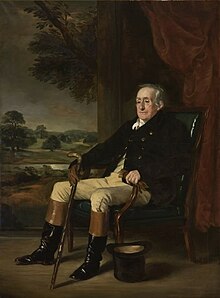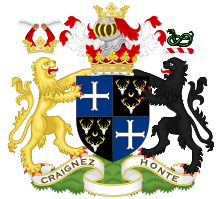William Bentinck, 4th Duke of Portland
The Duke of Portland | |
|---|---|
 Portrait by Francis Grant, c. 1852 | |
| Lord Privy Seal | |
| In office 30 April 1827 – July 1827 | |
| Monarch | George IV |
| Prime Minister | George Canning |
| Preceded by | The Earl of Westmorland |
| Succeeded by | The Earl of Carlisle |
| Lord President of the Council | |
| In office 17 August 1827 – 21 January 1828 | |
| Monarch | George IV |
| Prime Minister | The Viscount Goderich |
| Preceded by | The Earl of Harrowby |
| Succeeded by | The Earl Bathurst |
| Member of Parliament for Petersfield | |
| In office 29 December 1790 – 18 April 1791 | |
| Preceded by | Hon. George North William Jolliffe |
| Succeeded by | Welbore Ellis William Jolliffe |
| Member of Parliament for Buckinghamshire | |
| In office 18 April 1791 – 30 October 1809 | |
| Preceded by | The Earl Verney James Grenville |
| Succeeded by | Earl Temple William Selby Lowndes |
| Personal details | |
| Born | William Henry Cavendish-Bentinck 24 June 1768 London, England[1] |
| Died | 27 March 1854 (aged 85) Welbeck Abbey, Nottinghamshire, England |
| Political party | Conservative |
| Spouse | |
| Children | 9, including William, John, George, and Henry |
| Parent(s) | William Cavendish-Bentinck, 3rd Duke of Portland Lady Dorothy Cavendish |
William Henry Cavendish-Scott-Bentinck, 4th Duke of Portland, PC (24 June 1768 – 27 March 1854), styled Marquess of Titchfield until 1809, was a British politician who served in various positions in the governments of George Canning and Lord Goderich.
Background and education
[edit]Portland was the eldest son of Prime Minister William Cavendish-Bentinck, 3rd Duke of Portland and Lady Dorothy, daughter of William Cavendish, 4th Duke of Devonshire and Charlotte Boyle, Baroness Clifford. He was the elder brother of Lord William Bentinck and Lord Charles Bentinck.[2]
He was educated first in Ealing under the tutelage of Samuel Goodenough graduating in 1774, followed by Westminster School (1783). He attended Christ Church, Oxford for two years but did not take a degree.[1] The third Duke, who spared no expense for his heir, sent him to The Hague in 1786 for experience working with the crown's envoy, Sir James Harris. He returned in 1789.[3]
He later received an honorary degree of Doctor of Civil Law from Oxford in 1793.[1] He also served as a Family Trustee of the British Museum;[2] in 1810, he loaned the famed Portland Vase to the museum.[4]
Political career
[edit]
Portland was Member of Parliament for Petersfield between 1790 and 1791 and for Buckinghamshire between 1791 and 1809.[3]
He served under his father as a Lord of the Treasury between March and September 1807. He remained out of office until April 1827 when he was appointed Lord Privy Seal by his brother-in-law George Canning.[5] He was sworn of the Privy Council the same year.[5] When Lord Goderich became Prime Minister in August 1827, Portland became Lord President of the Council,[6] an office he retained until the government fell in January 1828. Over time the Duke became less of a staunch Conservative, softening to some of the more liberal stances of Canning.[1]
Portland also held the honorary post of Lord Lieutenant of Middlesex between 1794 and 1841.
Family
[edit]Portland married Henrietta, eldest daughter and heiress of Major-General John Scott of Fife and his wife Margaret (née Dundas), in London on 4 August 1795. At the time of his marriage he obtained Royal Licence to take the name and arms of Scott in addition to that of Cavendish-Bentinck. They were parents of nine children:[2][7]
- William Henry Cavendish-Scott-Bentinck, Marquess of Titchfield (22 October 1796 – 5 March 1824)
- Lady Margaret Harriet Cavendish-Scott-Bentinck (21 April 1798 – 9 April 1882)
- Lady Caroline Cavendish-Scott-Bentinck (6 July 1799 – 23 January 1828)
- William John Cavendish-Scott-Bentinck, 5th Duke of Portland (12 September 1800 – 6 December 1879)
- Lord William George Frederick Cavendish-Scott-Bentinck (27 February 1802 – 21 September 1848)
- Lord Henry William Cavendish-Scott-Bentinck (9 June 1804 – 31 December 1870)
- Lady Charlotte Cavendish-Scott-Bentinck (14 Jan 1806 – 30 September 1889), married Evelyn Denison, 1st Viscount Ossington
- Lady Lucy Joan Cavendish-Scott-Bentinck (27 August 1807 – 29 July 1899), married Charles Ellis, 6th Baron Howard de Walden
- Lady Mary Cavendish-Scott-Bentinck (8 July 1809 – 20 July 1874), married Sir William Topham
Death and legacy
[edit]The Duchess of Portland died on 24 April 1844.[1] Nearly 10 years later, Portland died at the family seat of Welbeck Abbey, Nottinghamshire, in March 1854, aged 85. Two of their sons predeceased their parents; their eldest dying of a brain lesion and their third son dying of a heart attack.
The duke expressed a desire to be buried in the open churchyard in Bolsover, Derbyshire, near the other family seat at Bolsover Castle. However, he was instead interred in the ancient Cavendish vault, that had previously been unopened for 138 years.[7]
He was succeeded in the dukedom by his second son (but the eldest surviving), William.
The department of Manuscripts and Special Collections, The University of Nottingham holds a number of papers relating to Portland: His personal and political papers are part of the Portland (Welbeck) Collection while the Portland (London) Collection contains papers relating to his estate business. The Portland Estate Papers held at Nottinghamshire Archives also contain items relating to Portland's properties.
Arms
[edit]
|
|
Titles
[edit]His full titles were Duke of Portland, Marquess of Titchfield, Earl of Portland, Viscount Woodstock, and Baron Cirencester.[2]
- The Most Honourable William Cavendish-Bentinck, Marquess of Titchfield (1768–1795)
- The Most Honourable William Cavendish-Scott-Bentinck, Marquess of Titchfield (1795–1809)
- His Grace The Duke of Portland (1809–1854)
Ancestors
[edit]| Ancestors of William Bentinck, 4th Duke of Portland | |||||||||||||||||||||||||||||||||||||||||||||||||||||||||||||||||||||||||||||||||||||||||||||||||||||||||||||||||||||||||||||||||||||||||||||||||||||||||||||||||||||||||||||||||||||||||||||||||||||||||||||||||||||||||||||||||||||||||||||||||||||||||||||||||||||||||||||||||||||||||
|---|---|---|---|---|---|---|---|---|---|---|---|---|---|---|---|---|---|---|---|---|---|---|---|---|---|---|---|---|---|---|---|---|---|---|---|---|---|---|---|---|---|---|---|---|---|---|---|---|---|---|---|---|---|---|---|---|---|---|---|---|---|---|---|---|---|---|---|---|---|---|---|---|---|---|---|---|---|---|---|---|---|---|---|---|---|---|---|---|---|---|---|---|---|---|---|---|---|---|---|---|---|---|---|---|---|---|---|---|---|---|---|---|---|---|---|---|---|---|---|---|---|---|---|---|---|---|---|---|---|---|---|---|---|---|---|---|---|---|---|---|---|---|---|---|---|---|---|---|---|---|---|---|---|---|---|---|---|---|---|---|---|---|---|---|---|---|---|---|---|---|---|---|---|---|---|---|---|---|---|---|---|---|---|---|---|---|---|---|---|---|---|---|---|---|---|---|---|---|---|---|---|---|---|---|---|---|---|---|---|---|---|---|---|---|---|---|---|---|---|---|---|---|---|---|---|---|---|---|---|---|---|---|---|---|---|---|---|---|---|---|---|---|---|---|---|---|---|---|---|---|---|---|---|---|---|---|---|---|---|---|---|---|---|---|---|---|---|---|---|---|---|---|---|---|---|---|---|---|---|---|---|
| |||||||||||||||||||||||||||||||||||||||||||||||||||||||||||||||||||||||||||||||||||||||||||||||||||||||||||||||||||||||||||||||||||||||||||||||||||||||||||||||||||||||||||||||||||||||||||||||||||||||||||||||||||||||||||||||||||||||||||||||||||||||||||||||||||||||||||||||||||||||||
See also
[edit]References
[edit]- ^ a b c d e "Death of the Duke of Portland". The Times. 29 March 1854. p. 11.
- ^ a b c d Debrett, John (1828). Debrett's Peerage of the United Kingdom of Great Britain and Ireland: Volume 1. Debrett's. p. 31.
- ^ a b "CAVENDISH BENTINCK (afterwards CAVENDISH SCOTT BENTINCK), William Henry, Mq. of Titchfield (1768–1854), of Welbeck Abbey, Notts". History of Parliament Online. Retrieved 24 March 2015.
- ^ "The conservation history of the Portland Vase". British Museum. Retrieved 24 March 2015.
- ^ a b "No. 18357". The London Gazette. 1 May 1827. p. 961.
- ^ "No. 18389". The London Gazette. 21 August 1827. p. 1785.
- ^ a b "Funeral of the Duke of Portland". The Times. 5 April 1854. p. 12.
External links
[edit]- Hansard 1803–2005: contributions in Parliament by the Duke of Portland
- Biography of the 4th Duke, with links to online catalogues, from Manuscripts and Special Collections, The University of Nottingham
| International | |
|---|---|
| National | |
| Other | |
Text is available under the CC BY-SA 4.0 license; additional terms may apply.
Images, videos and audio are available under their respective licenses.
